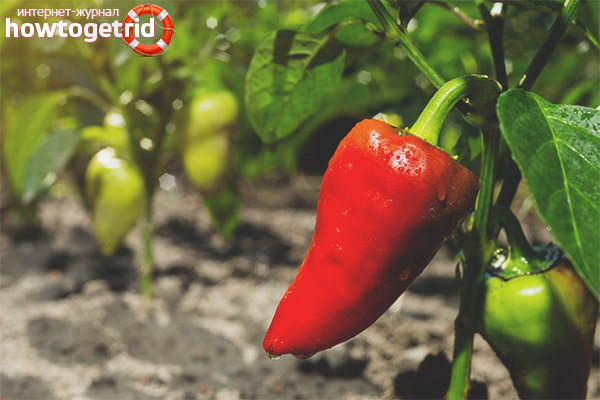The content of the article
Pepper is in great demand every year. Without it, it is difficult to imagine a vitamin salad or aromatic adjika. Red varieties with large fruits and thin skin are most in demand. They contain a large number of nutrients, and the taste is so rich that many eat it without additives, just rinsing the pepper under running water.
Grade characteristics
The pride of Russia belongs to the early ripe, the first crop is ready for 100-110 days planting field. At a low height, not more than 50-60 m. The bush has a powerful root system, which provides an influx of moisture and nutrients even in the dry period. The elastic trunk does not break during the spring winds, leaning to the ground and waiting for the weather. With a relatively small size on 1 plant, up to 20 ovaries are formed. As a result, with 1 sq.m. You can collect from 8 to 15 kg. fruits.
In the stage of technical ripeness, the pepper is dark green; gradually its color changes to red and the fruit has completely ripened and is almost burgundy. Its weight is 130-200 g., The pulp is dense, almost without bitterness, with a tart-sweetish tint.
Advantages and disadvantages
The variety turned out to be very successful, which proves its enduring popularity. Undoubted advantages include:
- friendly germination of seedlings;
- early bearing
- wide range of applications;
- endurance and unpretentiousness to the composition of the soil;
- small size of the bush;
- a large number of ovaries even in the cold summer;
- good storage quality;
- plentiful harvest;
- high taste.
Of the shortcomings noted:
- Sensitivity to lack of moisture.
- Demanding in the temperature regime, with a heat of more than +30, flower stalks can be reset.
- Planting seedlings should be carried out on 60-70 days after the seedling date, being late is fraught with the loss of half the crop.
- Low resistance to tobacco mosaic, fusarium, cladosporiosis.
The subtleties of growing
Special wisdom when cultivating the variety is not required. It is quite accessible not only to experienced gardeners, but also to beginning enthusiasts. Pepper feels great in a greenhouse and in open ground. To get an earlier crop, you will have to grow it through seedlings.
Important: when calculating the planting time, it must be borne in mind that the seeds germinate for a long time, up to 10 days, even in cooler temperatures. Planting in the ground is done after 2 months, so the seeds, soil mix and seedling containers must be prepared in mid-February.
The variety does not require special conditions, so you should adhere to the general rules of planting.
- Before planting, seeds are selected, soaked for 2 hours in a growth stimulator.
- A mixture of earth, humus, ash, pitch is suitable for planting. You can use ready-made soil for vegetables, which is sold in stores. Its value lies in the fact that the necessary fertilizers have already been made there for germinating sprouts and forming a strong root system.
- The landing depth is 1 cm, a distance of at least 2-3 cm.
Please note: the root system painfully responds to transplants, in order to avoid damage, it is more convenient to sow the seeds in peat cups or cassettes, so that afterwards they are not dived, but placed immediately on the beds or in the greenhouse.
In order for the plants to take root faster and better, after transplanting, fertilizing with complex fertilizer for vegetable crops is carried out, for example, Kemira - luxury, GUMI Kuznetsova.It is useful to make ash once in 14 days, to water it with a solution of mullein, to feed it with Agricola and Nitroammofosk preparations.
Pepper grows well in the beds, where before that there were legumes, pumpkin, onions, herbs, garlic. The soil is depressing after related species: eggplant, potato, tomato. They are susceptible to the same diseases and secondary infection with fungal infections can occur.
Strong and healthy plants will only be subject to a sufficient amount of nutrients in the soil. You can learn about their lack by the appearance of the bushes:
- Pale yellow leaves, small fruits - a lack of nitrogen, a solution of mullein will help.
- Dark specks and leaves twisted into a tube - not enough calcium, you need to stop the introduction of nitrogen.
- Reddish or bluish tint of leaf plates - phosphorus deficiency, superphosphate will help.
All proportions and norms of fertilizing are prescribed in the instructions, the main thing is to strictly follow the recommendations and remember that the lack and oversupply are equally detrimental to the plant.
Disease prevention is important because the variety has a low resistance. You will need regular inspection of the bushes and treatment with Trichocin, Funaben T. Preparations of garlic can be used for spraying garlic water at the rate of 150 gr. chopped garlic per 10 l. water.
The Pride of Russia variety is distinguished by the universality of fruits. They are perfectly pickled, frozen, used in salads, included in lecho, adjika, stored for a long time, and tolerate transportation well. Pepper is quite deservedly popular as one of the most productive among the early varieties.
Video: growing pepper from A to Z










Submit